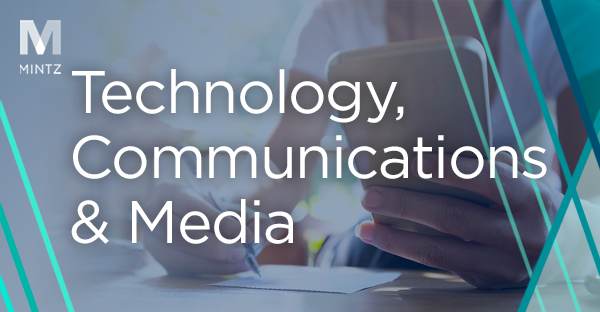What's New in 5G - March 2022
The next-generation of wireless technologies – known as 5G – is expected to revolutionize business and consumer connectivity, offering network speeds that are up to 100 times faster than 4G LTE, reducing latency to nearly zero, and allowing networks to handle 100 times the number of connected devices, enabling the “Internet of Things.” Leading policymakers – federal regulators and legislators – are making it a top priority to ensure that the wireless industry has the tools it needs to maintain U.S. leadership in commercial 5G deployments. This blog provides monthly updates on FCC actions and Congressional efforts to win the race to 5G.
Regulatory Actions and Initiatives
Spectrum
- The FCC moves closer to an auction of mid-band spectrum in the 2.5 GHz band to support next-generation 5G services.
- On February 9, 2022, the FCC’s Office of Economics and Analytics (“OEA”) and Wireless Telecommunications Bureau (“WTB”) released a Public Notice seeking further comment on the bidding procedures to be used for the auction of spectrum in the 2496-2690 MHz (“2.5 GHz”) band. Specifically, the Public Notice seeks comment on the potential use of a clock auction format to address concerns raised by commenters earlier in this proceeding about the previously proposed Simultaneous Multiple-Round and Single-Round Sealed-Bid auction formats. Comments were due February 23, 2022, with no opportunity for parties to submit reply comments.
- In addition, on February 18, 2022, OEA and WTB released a Public Notice announcing that the list of county and channel block combinations potentially available in the 2.5 GHz auction has been updated. It seeks comment on whether any procedures need to be adjusted for the updated list of licenses, including the minimum opening bids and upfront payment amounts for the additional licenses. Comments are due March 4, 2022, and, like the Public Notice above, there is no opportunity for parties to submit reply comments.
- Prior to releasing the Public Notices above, the WTB released a Public Notice announcing that seven additional applications filed during the 2.5 GHz Rural Tribal Priority Window were accepted for filing. Those applications, sorted by file number, are listed in Attachment A, and the same applications, sorted by applicant name, are listed in Attachment B. Petitions to deny those applications are due March 14, 2022. The Public Notice notes that the WTB has already granted 328 licenses to Tribes or Tribally-controlled entities.
- On February 22, 2022, FCC Chairwoman Rosenworcel suggested that, when Congress reauthorizes the FCC’s authority to auction spectrum, which is scheduled to expire on September 30, 2022, it should put revenue from upcoming spectrum auctions toward next-generation 911 services.
- On March 1, 2022, Chairwoman Rosenworcel announced that the 2.5 GHz auction will begin in July 2022.
- The FCC announces the acceptance of applications for licenses won in the latest auction of mid-band spectrum to support 5G services.
- On February 23, 2022, the FCC announced that it accepted for filing 23 applications for spectrum in the 3.45-3.55 GHz band. Bidding for that spectrum concluded on January 4, 2022 and resulted in 23 bidders winning a total of 4,041 licenses. A list of the applications sorted by applicant is available here, and a list of the applications sorted by market is available here. Petitions to deny the applications are due March 7, 2022, oppositions to those petitions are due March 14, 2022, and replies are due March 21, 2022.
5G Networks and Infrastructure
- The FCC highlights the substantial demand for funding to remove insecure equipment and services from U.S. communications networks and announces the deadline for filing annual reports.
- On February 4, 2022, the FCC issued a News Release announcing that FCC Chairwoman Rosenworcel has notified Congress that the Commission received over 181 applications to participate in the Supply Chain Reimbursement Program to fund the removal and replacement of communications services and equipment that pose a national security risk. The applicants have requested approximately $5.6 billion in funding, which is approximately $3.7 billion more than the $1.9 billion that was allocated by Congress.
- FCC Chairwoman Rosenworcel commented that she “look[s] forward to working with Congress to ensure that there is enough funding available for this program to advance Congress’s security goals and ensure that the U.S. will continue to lead the way on 5G security.”
- In addition, the FCC’s OEA and Wireline Competition Bureau released a Public Notice announcing that the FCC has established an online portal for providers of advanced communications services to report the extent to which their networks contain or use communications equipment or services on the FCC’s covered list that pose a national security risk. The report must be submitted by May 5, 2022, regardless of the provider’s participation in the Supply Chain Reimbursement Program.
- FCC releases a draft Second Further Notice of Proposed Rulemaking on pole attachments.
- The FCC has issued a draft Second Further Notice of Proposed Rulemaking (“FNPRM”), which is scheduled to be considered at the Commission’s March 16, 2022 meeting.
- In the draft FNPRM, the Commission seeks information to evaluate new and clarified rules regarding pole attachments, and, in particular, situations where a pole needs to be replaced to accommodate a new attachment.
- The Commission explains that pole attachments, and, in particular, issues associated with pole replacements, have the potential to significantly inhibit the deployment of broadband infrastructure.
- The Commission’s inquiries focus generally on ways to facilitate the resolution of pole replacement and pole attachment rate disputes, including which party or parties benefit and which party or parties should pay for pole replacements, including when the replacement is not necessitated solely by a new attachment request and where early pole retirement may benefit the pole owner.
- Notably, the Commission seeks input on measures it might take to expedite pole attachment complaint resolutions.
- The Commission also seeks input on the scope of refunds when ordered by the Commission because a pole attachment rate, term, or condition is unjust and unreasonable.
- FCC adopts new rules governing access to multi-tenant environments.
- On February 15, 2022, the FCC released a Report and Order and Declaratory Ruling (“Order”) adopting new rules prohibiting telecommunications providers and multi-channel video programming (“MVPD”) providers from entering into certain types of revenue sharing agreements with multi-tenant environment (“MTE”) landlords and requiring providers to disclose the existence of exclusive marketing agreements with MTEs in plain language. It also clarifies that existing FCC rules regarding cable inside wiring prohibit “sale-and-leaseback” arrangements.
- Scope
- The rules apply to communications services provided by: (1) telecommunications carriers in both commercial and residential MTEs, and (2) MVPDs subject to 47 U.S.C. § 548(b) in residential MTEs.
- The rules do not apply to entities that provide only broadband Internet access service.
- “MTEs” are defined as any contiguous premise under common ownership or control that contains two or more distinct units occupied by different tenants.
- The examples the FCC gave include apartment buildings (rental, condominium, or co-op), office buildings, office parks, shopping centers, and manufactured housing communities.
- This suggests that the rules are not limited to single buildings.
- The rules prohibit providers from entering into exclusive and graduated revenue sharing agreements with an MTE owner.
- “Exclusive” revenue sharing agreements are agreements in which providers offer consideration to MTE owners in exchange for access to the building and that prohibit the MTE owner from accepting similar consideration from another provider.
- “Graduated” revenue sharing agreements are agreements in which a provider pays an MTE owner a greater percentage of revenue as its penetration in the building increases.
- The prohibition on exclusive and graduated revenue sharing agreements applies both to agreements entered into after the effective date of these rules and those already in existence when the rules become effective.
- The Commission gives providers who are parties to existing exclusive or graduated revenue sharing agreements 180 days after the Order is published in the Federal Register to come into compliance.
- The Commission also requires providers to disclose the existence of exclusive marketing arrangements that they have with MTE owners.
Other Regulatory Actions
- The FCC and NTIA establish a new spectrum coordination initiative.
- On February 15, 2022, the FCC and the National Telecommunications and Information Administration (“NTIA”) announced a new initiative to improve U.S. government coordination on spectrum management. In particular, the agencies have committed to reinstating regular meetings to conduct joint spectrum planning, updating the nearly 20-year-old Memorandum of Understanding between the agencies to address gaps in government coordination, collaborating to help inform the development of a national spectrum strategy, recommitting to develop processes for spectrum engineering compatibility analysis, and fostering proactive technical exchange and engagement with industry and other federal agencies by participating in cross-agency advisory groups. The FCC’s News Release is available here, and NTIA’s post about the initiative is available here.
- The Government Accountability Office releases a report on NTIA spectrum-related IT modernization efforts.
- On February 17, 2022, the U.S. Government Accountability Office (“GAO”) released a Report describing (1) the existing spectrum-related IT that certain federal agencies employ to manage their spectrum use, and (2) the opportunities covered agencies and NTIA identified for improving spectrum management through IT modernization. Among other things, the GAO found that all covered agencies rely in part on NTIA-provided IT to manage spectrum use, most agencies – particularly the Department of Defense and Federal Aviation Administration – augment NTIA-provided IT with some additional spectrum-related IT that meets their unique mission needs, and many agencies broadly agreed that IT modernization could improve spectrum management. The Report notes that GAO will address oversight of the agencies’ spectrum-related IT modernization implementation efforts in the future.

What’s New in 5G - February 2022
February 2, 2022| Blog

What’s New in 5G - January 2022
January 5, 2022| Blog

What’s New in 5G - December 2021
December 3, 2021| Blog
Authors
T. Scott Thompson
Member / Chair, Communications Infrastructure Litigation Practice
Scott serves as Chair of Mintz’s Communications Infrastructure Litigation Practice and represents clients in legal, regulatory, and policy matters involving telecommunications networks.
Angela Y. Kung
Member / Chair, Technology, Communications & Media Practice
Angela Y. Kung draws on significant knowledge of the wireless regulatory landscape and experience at the FCC to advise clients on FCC rules and procedures. With particular expertise on spectrum use policies and auction procedures, she has shepherded Mintz's clients through several FCC auctions related to next-generation 5G wireless technologies and routinely advocates on behalf of clients to help ensure that the agency’s rules align with their interests.
Christen B'anca Glenn
Of Counsel
Christen B'anca Glenn is a Mintz attorney who advises communications and technology clients on regulatory and compliance matters before the FCC.



